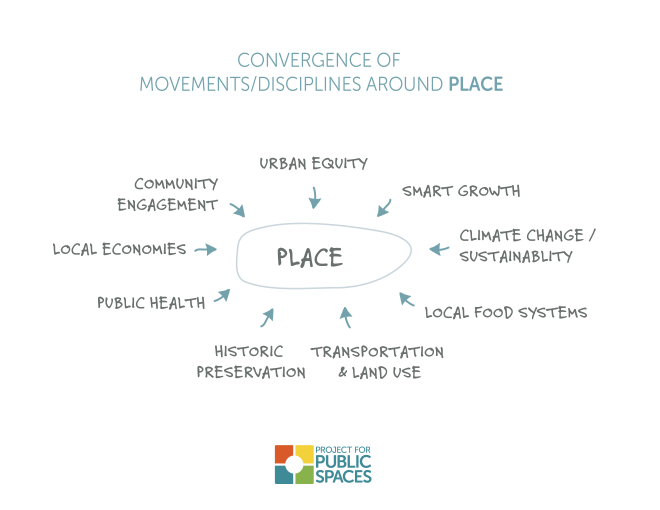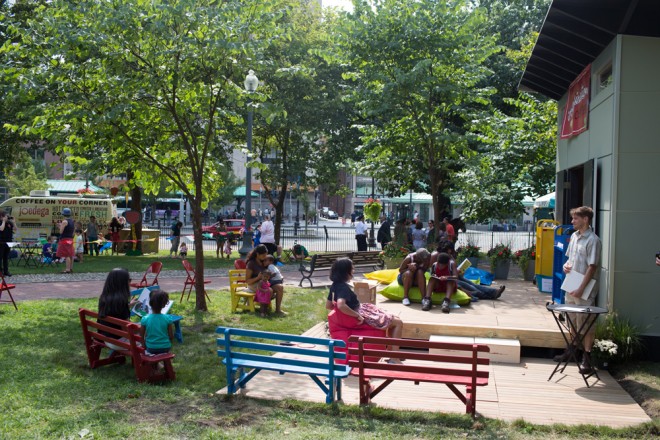A biweekly newsletter with public space news, resources, and opportunities.
A curated dispatch on all things public markets plus the latest announcements from the Market Cities Program.
There are myriad issues that government agencies, NGOs, and philanthropic organizations must address in their efforts to strengthen communities—economic growth, environmental degradation, affordability, social isolation, access to affordable food and services, freedom of self-expression, to name only a few. Rather than tackling each of these issues separately, more and more groups are aligning around Placemaking as a strategy that not only addresses these disparate agendas, but also shines a light on the critical ways in which they intersect. Quickly catching on to this trend, organizations are beginning to fund multiple Placemaking projects and programs. This is exciting news for Placemakers and communities everywhere!

Don’t get us wrong—one of PPS’s Eleven Principles of Placemaking is that “money is not the issue,” and we still firmly believe this to be true. However, for projects that have a coherent community vision and ready partners, but lack the resources to execute that vision, securing funding can be the spark that turns impassioned ideas into reality. This funding can also help take successful “Lighter, Quicker, Cheaper” programs to the next level—with huge benefits for the community as a whole.
After the Placemaking Leadership Council meeting in Pittsburgh, PPS hosted the first ever Placemaking Funders Forum. The event brought together a diverse group of 18 foundations, public agencies, national associations, crowdfunding organizations, corporate funders, non-profit intermediaries and their partners to discuss common challenges of funding Placemaking initiatives, and to find ways to share information to further leverage the impact of their programs. The discussion was masterfully facilitated by Tony Macklin of the Roy A. Hunt Foundation (Tony previously launched the Inspiring Places Initiative, in collaboration with PPS, at the Central Indiana Community Foundation).

The very diversity in the types of organizations at this forum is itself a testament to Placemaking’s capacity for bridging a wide range of traditional funding categories—community development, civic engagement, arts and culture, environment, and health.
Across their varied missions, attendees found themselves facing many of the same questions:
Together, by sharing resources and experiences, this group will create scalable, accessible tools to help measure and communicate the outcomes of Placemaking projects more effectively. This is a critical step in bolstering the “case-making for Placemaking,” as one attendee put it, and it will be another resource from which zealous nuts and place managers can draw, as they work to enhance their public spaces.
Another big step for Placemaking funding comes from the Kresge Foundation, which has long offered visionary leadership for Placemaking as a philanthropic strategy. Their support for the Placemaking Leadership Council is providing dedicated resources to foster the vigor and growth of Placemaking networks.
The Placemaking Funders Forum will be brought under the umbrella of the Leadership Council, with PPS continuing to serve as a facilitator—connecting funders, communities, and public space managers with relevant funding programs and useful tools. We’d love to hear more input about how Placemaking funding can be made more effective. Please let us know what you’re thinking: leadershipcouncil@pps.org.
The rich text element allows you to create and format headings, paragraphs, blockquotes, images, and video all in one place instead of having to add and format them individually. Just double-click and easily create content.
The rich text element allows you to create and format headings, paragraphs, blockquotes, images, and video all in one place instead of having to add and format them individually. Just double-click and easily create content.
Body Text Body Link
The rich text element allows you to create and format headings, paragraphs, blockquotes, images, and video all in one place instead of having to add and format them individually. Just double-click and easily create content.
Here is some highlighted text from the article.




Headings, paragraphs, blockquotes, figures, images, and figure captions can all be styled after a class is added to the rich text element using the "When inside of" nested selector system.
Headings, paragraphs, blockquotes, figures, images, and figure captions can all be styled after a class is added to the rich text element using the "When inside of" nested selector system.
Headings, paragraphs, blockquotes, figures, images, and figure captions can all be styled after a class is added to the rich text element using the "When inside of" nested selector system.